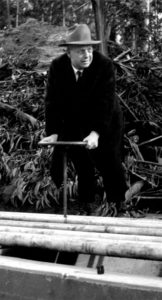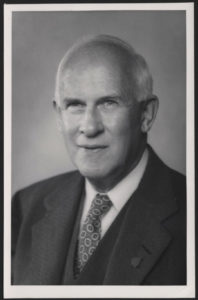The CWEA History Committee’s Mission Statement, like all good mission statements, provides the Committee with a basis for developing and organizing its various tasks each year. Our Mission is:
“To collect publications and articles, photographs, and other memorabilia of the Association, sections, committees, programs and Leaders. The Committee will organize, catalog and archive materials. Also, it seeks to enhance the reputation of the Association through material memorializing the Association.”
Keeping the Mission in mind, one of our ongoing tasks is to document and memorialize the leadership of CWEA, particularly our early leadership.
Have You Ever Wondered?
Maybe you’ve noticed the list of CWEA Past Presidents at the back of an annual conference program, or perhaps you might have seen the names of Past Presidents engraved on the Association’s bell that is used to open CWEA Board meetings and conference business meetings. Maybe you wondered about the people listed during the early years of our Association – who were they? What did they do? What were their contributions to the Association? I know that I often wondered about the people who served as CWEA President, and particularly those who served during the 1930’s and 1940’s when our Association was developing and growing.
The Past President Project 2014-2015
As the History Committee started to review our archives, it was found that the biographical documentation of our Association’s Past Presidents for CWEA’s first decade was noticeably lacking and photographs of our Past Presidents were almost non-existent. Thus, the challenge of documenting our early Past Presidents is the perfect task for the CWEA History Committee. The best place to start is at the beginning, so the History Committee initiated a project to memorialize CWEA’s first ten Presidents (1929-1939) for our 2014-2015 program of work.
We learned, quite quickly, that this is not a simple task. In fact it is more like detective work than simply archiving and compiling old documents! Our project has required the extensive mining of libraries, university archives, working with historical societies and other associations and even contacting the families of the early CWEA Past Presidents to obtain papers and photographs. The project is well worth the effort – we now have eight “mini-biographies”, complete with photographs, of our Association’s Past-Presidents spanning the 1928-1939 period.1
Truly Wastewater Professionals
Not surprisingly, the Presidents for CWEA’s first decade were true leaders in the wastewater field and helped to shape our industry and position CWEA for the future. Our first Presidents were academics, engineers, scientists, published authors, city managers, and hands-on operators. They pioneered new treatment and collection technologies, developed the first regional wastewater agencies in California and established industry standards and programs, while developing the CWEA into a professional association.
The History Committee is pleased to be able to present in this article, the Committee’s memorial biographies for CWEA’s first two “heads of state”; Albert K. Warren and Leon Benedict Reynolds.
 ALBERT KENDALL WARREN
ALBERT KENDALL WARREN
(1887-1941)
Chairman of the 1928 California Sewage Works Association Organizing Committee, Founding Member of California Water Environment Association (CWEA), First “Chairman” of the Association, and Chief Engineer and General Manager of the Los Angeles County Sanitation Districts
Albert Kendall (A.K.) Warren was born in Stoughton, Wisconsin, on August 11, 1887. He received his formal education as an engineer in the schools of Illinois, and served from 1908 to 1914 as an “engineer of reconnaissance, location, and construction (surveyor)” for the Canadian Northern Railway in the Pacific Northwest.
In 1914 Warren was employed by the Los Angeles County Flood Control District as an assistant office engineer. In 1915 he then joined the staff of the Los Angeles County Surveyor and served as a construction engineer and deputy county surveyor until 1924. On March 4, 1925 Warren was appointed as Chief Engineer and General Manager of the newly formed Los Angeles County Sanitation Districts, a position he held until his untimely passing in 1941.
The most notable achievement of Warren’s engineering career was his initial concept and development of the Los Angeles County Sanitation Districts from the inception of the enabling legislation to the completion of the District wastewater system – one of the largest regional wastewater collection, treatment, and disposal systems in the world.
Warren served as the Chairman of the 1928 California Sewage Works Association Organizing Committee, and as such, was our Association’s first leader and a charter member. He chaired the first annual conference of the California Sewage Works Association (CSWA) in San Bernardino, calling the meeting to order and officially opening the conference on October 9, 1928.
Warren served on the CSWA Board of Directors and CSWA Committees from 1928 to 1941, and published many technical articles in the CSWA Journal and Federation Journal. He received national recognition for his work in sanitary engineering and was active in the American Society of Civil Engineers, the Los Angeles Chamber of Commerce, and he was a member of the Jonathan Club in Los Angeles.
Albert Kendall Warren will always be remembered for his numerous contributions to the wastewater field, regional governance, and for his key role in the founding of the CWEA.
 LEON BENEDICT REYNOLDS
LEON BENEDICT REYNOLDS
(1884 – 1955)
First President and Charter Member of the California Water Environment Association (1929) (formerly California Sewage Works Association), and Professor of Hydraulic and Sanitary Engineering, Stanford University
Professor Reynolds was born in Hillsdale, Michigan, on December 29, 1884. In 1906 he received an A.B. degree from Hillsdale College, and then enrolled at Stanford, where he gained an A.B. degree in Civil Engineering in 1909. Following graduate work at Cornell, he joined Burns and McDonnell, Consulting Engineers of Kansas City, and became a member of that firm in 1920. In 1923 he returned to Stanford, and was Professor of Hydraulic and Sanitary Engineering until his retirement in 1950. In 1932, he was awarded an honorary Sc.D. degree by Hillsdale College.
Professor Reynolds taught hydraulic and sanitary engineering in the Civil Engineering
Department for 27 years, and was a lecturer on environmental hygiene for the Stanford Medical School for much of that time. In all of his classes, a primary objective was to teach highly professional and ethical standards. He made students and former students his life’s work both inside and outside the classroom. He was faculty adviser of the Stanford Student Chapter, American Society of Civil Engineers, for nine years (1929-36 and 1941-44), and was always an active and enthusiastic supporter of the group, even in his emeritus years. He maintained an up-to-date directory of all his former students, and called on all those he could reach in his extensive travels.
In 1928 the California Sewage Works Association (CSWA) was formed with Albert K. Warren serving as the Chairman of the Organizing Committee. Upon adoption of the CSWA Constitution and Bylaws at the October 1928 meeting of the CSWA, Chairman Warren called for the report of the Nominating Committee. The Nominating Committee advanced Professor Reynolds as the first President of our Association, and he was elected by a unanimous vote of the membership. Professor Reynolds went on to serve as President, chaired and served on several CSWA committees, and published numerous articles in the Association Journal. He also served as the CSWA Board Member on the Federation of Sewage Works Associations Board of Control (now the Water Environment Association – WEF) for 1930-31. In 1944, he received the Kenneth Allen Award for Outstanding Service to a Member Association from Federation of Sewage Works Associations (now known as the Arthur Sidney Bedell Award).
In addition to the CWEA and WEF, Professor Reynolds was an active member and held high offices in many other professional societies. He was a member of the American Society of Civil Engineers for 45 years and, among other offices, was president of the San Francisco section. The list of organizations also included the American Public Health Association, the American Water Works Association, and the California Sewage Works Association. He was also a member of Tau Beta Pi and Sigma Xi honorary scholastic and scientific societies.
Professor Reynolds was a talented professional man, and was one of the first registered civil engineers in California. He was author of numerous technical articles in the field of sanitary engineering and wrote the chapters on Water Purification, Sewage Treatment, and Refuse Disposal in “Essentials of Public Health”, by William P. Shephard (J. P. Lippencott, 1948). He also served as a sanitary engineering consultant to San Francisco and numerous other California communities.